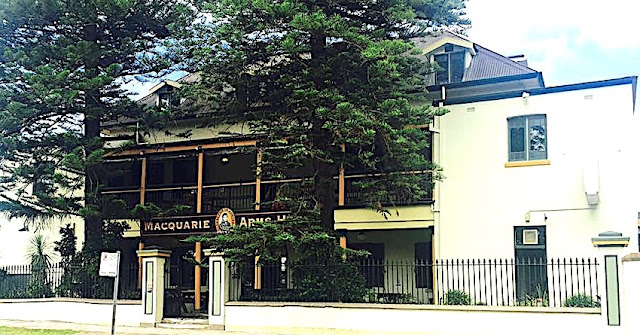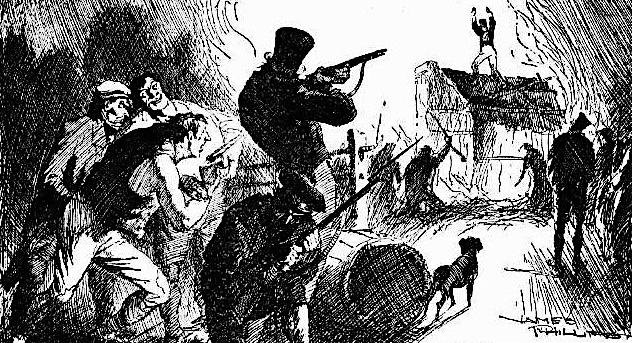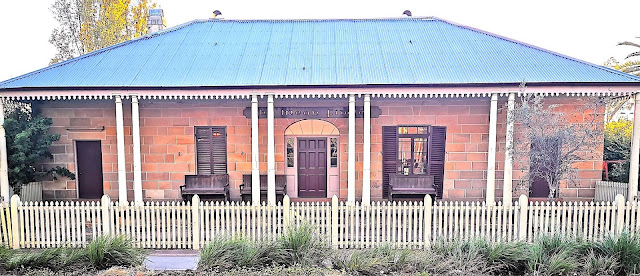 |
Juniper Hall, Paddington, one of Australia's oldest houses, was reportedly designed by Robert Cooper (Big Cooper), an emancipist gin distiller, who had it built circa 1824-5 |
"Paddington has been, in turn, a high class residential area graced by Georgian mansions built on wooded slopes and set among formal gardens, vine-yards and orchards; a working class suburb, treeless and scarred with serried rows of cheap terrace houses; a slum on the edge of Sydney’s underworld; and, to complete a full circle, today’s fashionable suburb..."
Hemisphere.Vol. 15 No. 10 (October 1971)
Juniper Hall, Paddington, one of Australia's oldest houses, was reportedly
designed by Robert Cooper (Big Cooper), an emancipist gin distiller, who had it built circa 1824-5. Robert had been sentenced to
14 years transportation for smuggling.
 |
| Sydney Gazette and New South Wales Advertiser (NSW : 1803 - 1842), Tuesday 6 March 1832, |
Robert Cooper was a ship owner, inn keeper, timber merchant, auctioneer, pastoralist, manufacturer, baker, brewer and, more successfully, a gin distiller, which inspired the name of his home,
 |
| Maitland Daily Mercury (NSW : 1894 - 1939), Friday 13 November 1908, |
Juniper Hall has been the residence for institutions including the Society for the Relief of Destitute Children, The Deaf Dumb and Blind Institute, several ladies’ colleges and the State Children’s Relief Board. (terminology of the times)
Juniper Hall was leased to Judge John Kinchela in 1831 — the colony’s first Attorney General, and Robert Cooper and his family
moved to their George Street residence. Judge Kinchela then changed the name to Ormonde House.
 |
| Padding looking east from Oxford Square, NSW. Australian Town and Country Journal (Sydney, NSW : 1870 - 1919), Wednesday 13 November 1912 |
 |
| Oxford-street, Paddington. NSW, Australian Town and Country Journal (Sydney, NSW : 1870 - 1919), Wednesday 17 December 1913 |
In 1925, Juniper Hall was set to be demolished. But Paddington residents were outraged, which led to the building being divided into flats and named Hillside.
A row of six shops were
built in the front garden.
Juniper Hall was purchased by the National Trust in 1984, and this heritage-listed Georgian house was later restored.
In 1987, six adjoining shops
opposite Paddington’s Town Hall in Oxford Street were demolished, revealing Juniper Hall.
The Moran family purchased Juniper Hall from the National Trust of Australia on a 99-year lease in 2012 for $4,551,000 to become the home of the Moran Arts Foundation.
Juniper Hall is now the permanent venue for the annual Moran Art Prizes exhibition.
After a walk around Juniper Hall, many
visitors visit the cafe.
Interesting Facts
Oxford Street was also a walking track used by Aboriginal people.
A road through the future Paddington area was built by Governor Hunter to South Head as early as 1803.
The first land grant in the Paddington area, of 100 acres (40.4 hectares), was made to Robert Cooper, James Underwood, and Francis Ewen Forbes by Governor Brisbane in 1823.
Victoria Barracks was constructed between 1841 and 1849.
In 1862 there were 535 houses at Paddington with 2,800 residents.
Sir Henry Parkes laid the foundation stone for the Paddington Town Hall in 1890.
The Paddington Reservoir in Oxford Street provided water to parts of Sydney between 1866 and 1899.
White City Tennis Centre has been a big part of Australian Tennis since its opening in 1922.
Lost
 |
Barcom Glen, Darlinghurst, the historic home of the West family, is about to be effaced, in order to make way for a modern street. The old house, built solidly of stone, cut from the once splendid quarries on the estate, stands lonely now amidst surroundings, which have vastly changed since its foundations were laid scores of years ago. In 1804 a grant of 76 acres was made to Thomas West, and the estate stretched from Oxford-street to the waters of Rushcutter Bay. Sydney Morning Herald (NSW : 1842 - 1954), Thursday 8 February 1912
Some Paddington Historic Photos
 | Horse-drawn omnibus on Oxford Street, Paddington, NSW, 1895 BY MACPHERSON FAMILY, SLNSW
|
 | | Paddington Town Hall in 1900, NSW, Woollahra Municipal Council |

Rose, Shamrock & Thistle Hotel, 55 Oxford Street, Paddington, C. 1930s, by Sam Hood |
|
 |
| THESE BRIGHT-FACED GIRLS, employees of the N.S.W. Engineering Works at 363 Oxford Street,Paddington, were not perturbed today when they had to make this' rather unusual entry to the works. The boss left the key at home. Daily Mirror (Sydney, NSW : 1941 - 1955), Wednesday 19 February 1947 |
The first hotel was built on the intersection of Dowling and Oxford Sts. by Sgt. Armstrong of the Police Force. The first omnibus ran to Paddington and was called the Iron Duke. The track was rough and the fare was 1s each way.Daily Mirror (Sydney, NSW : 1941 - 1955), Wednesday 18 January 1950,
Heritage Listings
1 Ormond Street, Juniper Hall
Engehurst 246 Oxford Street:
1 Young Street: Paddington Substation
249 Oxford Street: Paddington Town Hall
255a Oxford Street: Paddington Reservoir
302–304 South Dowling Street: Saint Sophia's Cathedral, Sydney
The following sites are listed on other heritage registers
Paddington Court House, Jersey Road
Paddington Public School, 1870 and 1892 buildings, Oxford Street
Uniting Church and Parsonage, 1877, Oxford Street
St Matthias Church Group, 1859–1861, Oxford Street
St Matthias Former Rectory, 1873, 495 Oxford Street
St Matthias Church Hall, 1882, Oxford Street
Royal Hotel, 1885, Glenmore Road
Tabor Cottage, Jersey Road (formerly Paddington Watch House)
Around Paddington
 |
| Art display at Juniper Hall, Paddington, NSW |
 |
| Paddington Reservoir Gardens at 251-255 Oxford St, Paddington. The Paddington Reservoir is a heritage-listed public park located at 255a Oxford Street in the inner eastern Sydney suburb of Paddington |
 |
| Centennial Park's Paddington Gates, located on the corner Oxford Street and Lang Road, Paddington, NSW (All eight sets of entrance gates into Centennial Park were built between 1887 and 1900) |
 |
| Paddington Post Office built 1885. 246 Oxford Street, Paddington, NSW |
 |
| Heritage buildings, Paddington, NSW |
 |
| Victoria Barracks in Paddington, NSW, built in 1841, of locally quarried sandstone (for the use of Defence Personnel) |
 |
| The Superintendent's Residence, Parkes Dr, Centennial Park, Paddington, NSW, built from 1891 |
 |
| Former Paddington Watch House, now known as Taber Cottage (heritage-listed), Jersey Road Paddington, Sydney, NSW, Sardaka |
 |
| A tiny house in Paddington, NSW |
 |
| Paddington terraces, Paddington, NSW |
Things To See
There are many private art galleries in Paddington
Juniper Hall: 250 Oxford St, Paddington 2021. Telephone: (02) 9357 5222 (Open Days: Monday, Tuesday, Wednesday, Thursday, Friday, Saturday, Sunday)
Paddington Reservoir Gardens at 251-255 Oxford St, Paddington. The Paddington Reservoir is a heritage-listed public park
Centennial Park's Paddington Gate. Entrance to Centennial Park located on the corner Oxford Street and Lang Road, providing access from the eastern suburb of Paddington.
Paddington Markets is a not-for-profit artisan market featuring local artists, bakers, chefs and fresh produce. Every Saturday from 10am Paddington Markets has been open since 1973
Project Space Gallery: Australian Centre for Photography. Venue. 72 Oxford Street, Darlinghurst NSW
St Matthias Anglican Church, is located long Oxford Street, NSW
St Francis of Assisi Choir 9and church), Paddington, NSW
Paddington Library, 247 Oxford St, Paddington NSW
Paddington Uniting Church, 395 Oxford St, Paddington NSW 2021
























































